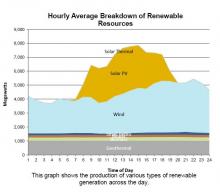Sunday Train has long supported the Steel Interstate concept … but Sunday Train is “merely” an online activity composed of my online blogging in various forums and your discussion in various forums. However, since 2013, I have also been involved in the advocacy of the Steel Interstate concept in a more direct collaboration organized by …
Tag: sustainable energy
Apr 27 2015
Sunday Train: Variable Renewables and Dispatchable Demand

But the efficiency gains of electric traction are only half of the story for sustainable transport, since its not fully sustainable unless that electricity is generated in a sustainable way.
And when following online discussion of renewable energy at the Energy Collective, which attracts both advocates for and detractors of investment in renewable energy resources, a perennial source of ammunition for attacks on renewable energy are the challenges of meeting demand for electricity with the harvest of a variable source of energy that is available on its own schedule, and not ours.
This is a topic I have touched on before (cf , ), Inspired by the article at the Energy Collective: Will Natural Gas Peaker Plants Become Obsolete?, I am coming back to today. What I want to focus on today is the opportunities offered by dispatchable demand for better integration of variable renewable energy. And I would be happy if you would join me to discuss this topic (or any other topic involving sustainable transport), below the fold.
May 06 2014
Sunday Train: Freight Transport and the Highway Funding Crisis
Belated edition ~ technical difficulties interfered with posting to Soap Blox blogs
 We are going to be hearing increasingly this year about the Highway Funding Crisis. Much of that discussion will be directed toward exploiting the political leverage that our car addiction gives to the Highway Lobby.
We are going to be hearing increasingly this year about the Highway Funding Crisis. Much of that discussion will be directed toward exploiting the political leverage that our car addiction gives to the Highway Lobby.
But there is the other side of the Highway Funding Crisis, which is freight transport. Our freight transport system has been as deliberately addicted to road funding as our passenger transport system, and in the process is quite heavily addicted to diesel fuel.
Now, the Sunday Train has frequently tackled this issue from the side of the physical unsustainability of our dependence on petroleum based fuels for a majority of our transport. However, its also the case that the system of public finance upon which we built our road transport system is becoming more and more financially unsustainable.
Dec 23 2013
Sunday Train: Bringing This Oil Tanker to a Halt
 Its been said that it takes miles for a fully-loaded super-tanker to come to a stop, because an ordinary stop takes 20 minutes, and even an emergency, or “crash”, stop takes 14 minutes. But that is less than the blink of an eye compared to the time it will take to bring the emissions of CO2 to a stop.
Its been said that it takes miles for a fully-loaded super-tanker to come to a stop, because an ordinary stop takes 20 minutes, and even an emergency, or “crash”, stop takes 14 minutes. But that is less than the blink of an eye compared to the time it will take to bring the emissions of CO2 to a stop.
As Do the Math reminds us, in order to have some plausible chance (far short of certainty, by the way) of leaving global warming at under the 3.6°F that implies that the already ongoing climate catastrophe tips over into the super-catastrophe range, we need to keep additional CO2 emissions at under 565 gigatons. And we have computed reserves equivalent to 2,795 gigatons. So we must, by hook or by crook, find a way to refrain from consuming 80% of our CO2.
For the US, our main focus has to be on our energy emissions due to petroleum, coal, and natural gas, since 85.7% of our total CO2 emissions are due to energy production. As of 2011 41% of our emissions from energy production comes from petroleum emissions, 34% from coal, and 24% from natural gas. Of that 41% due to petroleum, 15% is from domestic petroleum production, and 26% from petroleum imports. So if the United States were to today achieve petroleum independence from carbon-neutral energy sources and energy savings, and totally replace coal combustion with carbon-neutral energy sources and energy savings, that would save 60% of the 86% of emissions from energy production, or 52% of the total. We would “only” have to cut the remaining energy-related emissions and the 14% from other sources by 60% to get to an equal proportional share of an 80% reduction.
However, the target we have to aim at is more ambitious than this. First, fossil fuels are non-renewable, and our timeline for the persistence of CO2 in the atmosphere is around a century. We don’t have a century’s worth of fossil fuels at the current rate of global consumption, so cutting back our consumption by 80% of the present rate is not enough.
And second, because of the time that it will take to switch to a low carbon emissions society, it is highly likely that by the time that a low carbon emissions society is within reach, we will have already emitted close to 565 gigatons.
This is why our target is no longer a “low net carbon emissions” society, but a “zero net carbon emissions” society, since we’ve likely already passed the “ordinary stop” stopping distance, and are coming up upon the “crash stop” stopping distance.
Sep 30 2013
Sunday Train: Unleashing the Political Power of Bio-Coal
 One point that constantly comes up when the push to 100% sustainable, renewable power is raised is the problem that “renewable power sources cannot be relied on to deliver power 24/7”. This is a talking point pushed by the propagandists for Big Coal in particular, since the biggest challenge to their long term existence as an industry in the United States is the threat that we begin to get serious about tapping our abundant Wind Power resources on-shore in the Great Plains and Mountain West and off-shore on the Great Lakes and Atlantic Coast. When the wind is blowing, it substantially undermines the market for fossil-fuel “Baseload Power” (see (The Myth of Baseload Power).
One point that constantly comes up when the push to 100% sustainable, renewable power is raised is the problem that “renewable power sources cannot be relied on to deliver power 24/7”. This is a talking point pushed by the propagandists for Big Coal in particular, since the biggest challenge to their long term existence as an industry in the United States is the threat that we begin to get serious about tapping our abundant Wind Power resources on-shore in the Great Plains and Mountain West and off-shore on the Great Lakes and Atlantic Coast. When the wind is blowing, it substantially undermines the market for fossil-fuel “Baseload Power” (see (The Myth of Baseload Power).
After all, consider two scenarios, one in which a power source replaces half of the power from coal by replacing half the power, all of the time, and a second, in which a power source replaces all of the power, half the time. The second is a greater threat to coal-fired power, since it swings the advantage to natural-gas fired power. Natural-gas fired power is presently killing off coal-fired plant construction, and a sufficiently large and volatile supply of Windpower would make that permanent.
So of course Big Coal spreads the idea that all sustainable power is volatile and if its volatile, it can’t provide all of our power.
This present essay is not about answering that argument rationally. That was the topic of The Myth of Baseload Power. This present essay is about attacking the political foundations of Big Coal.
After all, propaganda about “Clean Coal” and spreading the myth that there is this special kind of power called Baseload power that sustainable energy has impact because of the political influence of Big Coal in Coal Country. And this is a particularly pernicious influence, since it runs on a cycle of:
- Coal production provides export base employment in an area.
- Coal production also diverts a majority of the value-added from production out of the production area;.
- which helps assure that the Coal production areas are, on average, lower income economies than elsewhere in the country;
- which undermines the area’s capability to diversify its economy, helping to assure that the jobs in Coal production are valued jobs in the local area, which increases local political support for “supporting” Big Coal;
- And with a less diversified economy, there are fewer resources available to contest the political power and influence of Big Coal.
- With its political power, Big Coal ensures that the rules in place continue to ensure that a majority of value-added is drained out of the production area
This essay is about undermining that political power at its base, by creating more jobs from a direct rival to coal production than Big Coal can offer. Once a better deal is made available, with more employment, more value-added circulating locally, and no destruction of people’s health through the hauling up of poisonous by-products from underground, the foundation on which Big Coal’s political power is based is in a position to fracture.
What is that direct rival to coal production? Bio-coal production.

Recent Comments